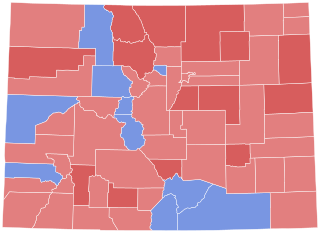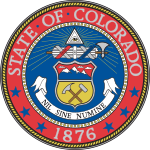
Presidential elections were held in the United States on November 5, 1996. Incumbent Democratic President Bill Clinton and his running mate, incumbent Democratic Vice President Al Gore were re-elected to a second and final term, defeating the Republican ticket of former Senate Majority Leader Bob Dole and former Secretary of Housing and Urban Development Jack Kemp and the Reform ticket of businessman Ross Perot and economist Pat Choate.

Richard Douglas Lamm was an American politician, writer, and attorney. He served three terms as the 38th Governor of Colorado as a Democrat (1975–1987) and ran for the Reform Party's nomination for President of the United States in 1996. Lamm was a Certified Public Accountant and was the co-director of the Institute for Public Policy Studies at the University of Denver.

The 1982 United States Senate elections were held on November 2, 1982. They were elections for the United States Senate following Republican gains in 1980. The 33 Senate seats of Class 1 were up for election in 1982. A total of four seats changed hands between parties, with Democrats winning seats in New Jersey and New Mexico, and Republicans taking seats in Nevada and the seat of the lone independent, Senator Harry Byrd Jr., in Virginia. Democrats made a net gain of one seat bringing them to 46 seats, while Republicans stayed at 54 seats for a majority. However, the Democratic gain in New Jersey replaced a Republican that had been appointed earlier in the year. Liberal Republicans senators in Connecticut, Rhode Island and Vermont held onto their seats, keeping the Senate in Republican hands.

United States gubernatorial elections were held on November 5, 2002, in 36 states and two territories. The Republicans won eight seats previously held by the Democrats, as well as the seat previously held by Minnesota governor Jesse Ventura, who was elected on the Reform Party ticket but had since renounced his party affiliation. The Democrats won 10 seats previously held by the Republicans, as well as the seat previously held by Maine governor Angus King, an independent. The elections were held concurrently with the other United States elections of 2002.

The 2008 congressional elections in Colorado were held on November 4, 2008, to determine who will represent the state of Colorado in the United States House of Representatives, coinciding with the presidential and senatorial elections. Representatives are elected for two-year terms; those elected served in the 111th Congress from January 3, 2009, until January 3, 2011.

The 1998 United States Senate election in Colorado was held November 3, 1998, alongside other elections to the United States Senate in other states as well as elections to the United States House of Representatives and various state and local elections. Incumbent Senator Ben Nighthorse Campbell won re-election to a second term by a landslide. This was Campbell's first election as a Republican as he left the Democratic Party in 1995.

The Reform Party of the United States of America (RPUSA) was founded in 1995 by Ross Perot. Because the party had just recently been formed, the traditional system of presidential primaries in use by the Republican and Democratic parties was not considered practical for the Reform Party to use for its presidential primary in 1996. Instead, a national primary was held through the mail in which Reform Party supporters voted for a number of candidates, while ballot efforts were concentrated entirely towards the general election.

The 2016 United States House of Representatives elections in Colorado were held on November 8, 2016, to elect the seven U.S. representatives from the state of Colorado, one from each of the state's seven congressional districts. The elections coincided with the 2016 U.S. presidential election, as well as other elections to the House of Representatives, elections to the United States Senate and various state and local elections. The primaries were held on June 28.

The 1912 Colorado gubernatorial election took place on November 8, 1912. Democratic state Senator Elias M. Ammons defeated the Progressive, Republican and Socialist candidates future Senator Edward P. Costigan, Clifford C. Parks and Charles A. Ashelstrom with 42.91% of the vote.

Dorothy Louise Vennard Lamm is an American feminist, women's rights activist, educator, author, and speaker. She was First Lady of Colorado during her husband Richard Lamm's three terms as Governor of Colorado (1975–1987), and unsuccessfully ran for the United States Senate as the Colorado Democratic candidate in 1998. She wrote a weekly column for The Denver Post from 1979 to 1996 and later published three books. She was inducted into the Colorado Women's Hall of Fame in 1985.

The 1990 Colorado gubernatorial election was held on November 6, 1990. Incumbent Democrat Roy Romer defeated Republican nominee John Andrews with 61.89% of the vote.

The 1978 Colorado gubernatorial election was held on November 7, 1978. Incumbent Democrat Richard Lamm defeated Republican nominee Ted L. Strickland with 58.76% of the vote.

The 1974 Colorado gubernatorial election was held on November 5, 1974. Democratic nominee Richard Lamm defeated incumbent Republican John D. Vanderhoof with 53.22% of the vote. This is the last time that an incumbent governor of Colorado lost re-election.

The 1970 Colorado gubernatorial election was held on November 3, 1970. Incumbent Republican John Arthur Love defeated Democratic nominee Mark Anthony Hogan with 52.46% of the vote. This would be the last time until 1998 that Colorado elected a Republican as Governor and also the last time Denver County, Boulder County, and San Miguel County voted for the Republican candidate.

The 1966 Colorado gubernatorial election was held on November 8, 1966. Incumbent Republican John Arthur Love defeated Democratic nominee Robert Lee Knous with 54.05% of the vote.

The 1962 Colorado gubernatorial election was held on November 6, 1962. Republican nominee John Arthur Love defeated Democratic incumbent Stephen McNichols with 56.67% of the vote.

The 1952 Colorado gubernatorial election was held on November 4, 1952. Incumbent Republican Daniel I. J. Thornton defeated Democratic nominee John W. Metzger with 57.08% of the vote.

The 1942 Colorado gubernatorial election was held on November 3, 1942. Republican nominee John Charles Vivian defeated Democratic nominee Homer Bedford with 56.23% of the vote.

The 1940 Colorado gubernatorial election was held on November 5, 1940. Incumbent Republican Ralph Lawrence Carr defeated Democratic nominee George E. Saunders with 54.37% of the vote.
Robert E. DeNier was a Republican legislator from Colorado, U.S. He served one four-year term in the Colorado Senate, from 1987 to 1991, and three two-year terms in the Colorado House of Representatives, from 1977 to 1983. In 1982, he was an unsuccessful candidate for lieutenant governor, running alongside gubernatorial candidate John D. Fuhr and losing to the governor/lieutenant governor candidates Richard Lamm and Nancy Dick.






















